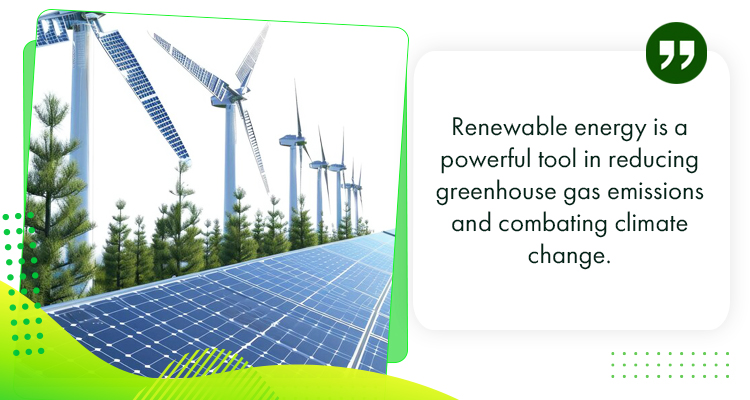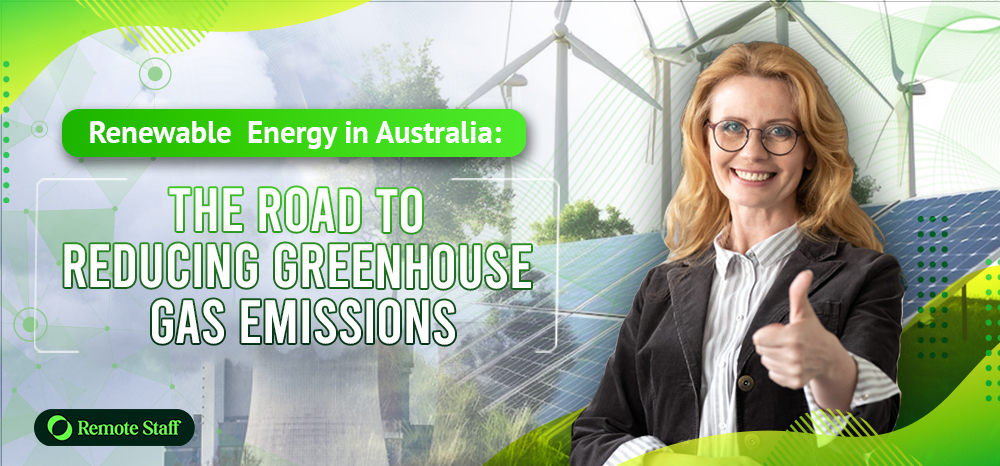As global temperatures and the need to transition to renewable energy continue to rise, the world faces what experts have termed global boiling, a dramatic shift beyond global warming that threatens ecosystems, livelihoods, and health.
As a precaution, the Australian government solidified its vision of a net zero future by passing laws requiring the nation to reduce its greenhouse gas emissions by 43% by 2030.
Fortunately, there are business opportunities in helping Mother Earth rehabilitate as well.
Keep reading to discover how renewable energy can provide a sustainable path forward, offering both environmental and economic benefits.

The Current State of Renewable Energy in Australia
Australia is making significant strides in the renewable energy industry, driven by its abundance of natural resources and compatible policies.
Here’s a closer look at the current situation Down Under:
Adoption Rates and Growth Trends
Renewable energy adoption rates in Australia have surged, with renewables contributing over 30% of the nation’s electricity supply in recent years.
Solar power and wind energy are leading these renewable energy growth trends, with substantial investments in infrastructure and technology driving further expansion.
Government Policies and Incentives
The Australian government supports renewable energy through various policies and incentives that encourage investment and development.
Initiatives such as the Renewable Energy Target (RET) and subsidies for solar panels and wind energy projects, for instance, have played a pivotal role in accelerating growth.

The Impact of Renewable Energy on Greenhouse Gas Emissions
Renewable energy is a powerful tool in reducing greenhouse gas emissions and combating climate change.
Here’s how.
Reduction in Carbon Footprint
Switching from fossil fuels to clean energy significantly reduces carbon footprints. In 2023, renewable energy generated in Australia went up to 39.4% from 35.9% in 2022.
Solar and wind energy produce no direct emissions, making them major players in the global effort to decrease greenhouse gas emissions. Through these renewable energy sources, Australia aims to achieve generating 82% renewable energy in its grid by 2030.
Comparative Analysis with Fossil Fuels
Compared to fossil fuels, renewable energy technology has a much lower environmental impact. Fossil fuels release large amounts of carbon dioxide and other pollutants, while renewables offer a cleaner, more sustainable alternative.
Environmental Impact:
- Fossil Fuels. The burning of fossil fuels (coal, oil, and natural gas) releases large amounts of carbon dioxide (CO2) and other greenhouse gases into the atmosphere, which exacerbate global warming and climate change.
- Renewable Energy. Renewable energy sources, such as solar and wind, produce little to no direct emissions. They generate clean energy with a much lower carbon footprint, making them a more sustainable option.
Sustainability:
- Fossil Fuels. Fossil fuels are finite. The extraction process becomes increasingly difficult and environmentally damaging as reserves dwindle.
- Renewable Energy. Renewable energy sources, such as solar, wind, and hydro, are abundant and naturally replenished. Solar and wind energy, in particular, are virtually inexhaustible, making them reliable long-term sources of energy.
Cost:
- Fossil Fuels. While historically cheaper due to established infrastructure, the costs associated with fossil fuels are rising, especially as resources become harder to extract. Additionally, there are hidden costs, such as environmental damage and health impacts, which are not always reflected in market prices.
- Renewable Energy. The initial setup costs for renewable energy technologies might be high, but ongoing costs are much lower compared to fossil fuels. Over time, the cost of renewable energy has been decreasing due to technological advancements and economies of scale.
Energy Efficiency:
- Fossil Fuels. Fossil fuel-based power plants generally operate at lower efficiency levels, losing a significant portion of energy as heat during the conversion process.
- Renewable Energy. Renewable energy technologies, especially modern solar panels and wind turbines, have improved in efficiency, converting a higher percentage of captured energy into usable electricity.
Reliability:
- Fossil Fuels. Fossil fuels provide consistent and reliable output, making them a staple source of energy. However, their environmental impact and the volatility of fuel prices are significant downsides.
- Renewable Energy. While renewable energy sources like solar and wind are intermittent (dependent on weather conditions), advancements in energy storage solutions (such as batteries) and grid management are addressing this inherent limitation.
A diverse energy mix that includes various renewables can provide a more stable and resilient power supply.
Case Studies and Real-World Examples
Several Australian projects underscore the effectiveness of renewable energy in reducing emissions.
For example, the Hornsdale Power Reserve, a large-scale battery installation in South Australia, has dramatically cut emissions by storing wind and solar power.
Another successful renewable energy project is the Limondale Solar Farm, RWE’s first Australian renewable project near Balranald, NSW.
It has 872,000 solar panels across 770 hectares with a capacity of 249 MWac, making it one of Australia’s largest solar farms. It powers approximately 105,000 homes annually.

Overview of Renewable Energy Sources
Australia harnesses various renewable energy sources, including solar power, wind energy, biomass, and hydrogen.
The use of solar panels and wind turbines is steadily increasing, what with the country’s sunny climate and windy coastlines.
Technological Advancements Driving Renewable Energy
Technological innovation is a key driver of the renewable energy revolution in Australia.
Innovations in Solar Power
Advancements in solar power technology, such as high-efficiency solar panels and battery storage solutions, have made solar energy more affordable and accessible.
Wind Energy Developments
Australia’s wind energy sector is growing, with new wind turbines being developed with enhanced design and efficiency. These advancements increase energy output and reduce costs.
Emerging Technologies: Hydrogen and Biomass
Emerging technologies like hydrogen energy and biomass are gaining traction. Hydrogen offers a clean fuel alternative, while biomass energy provides a renewable source for generating heat and power.
Economic and Social Benefits of Renewable Energy
Renewable energy not only protects the environment, but also offers significant economic and social benefits.
Job Creation and Economic Growth
The renewable energy sector is a major job creator, with thousands of new positions in solar, wind, and related industries.
This growth stimulates local economies and supports sustainable development.
Public Health and Environmental Benefits
By reducing air pollution and greenhouse gas emissions, renewable energy improves public health and contributes to a cleaner environment.
Community Initiatives and Local Projects
Community-driven renewable energy projects empower local areas, allowing residents to benefit from clean energy while fostering a sense of community ownership and engagement.
Australia’s community-driven renewable energy projects include:
- Hepburn Wind. The country’s first community-owned renewable energy project, which began generating power in 2011.
- Imagine 30kW Solar Farm. Developed by Clean Energy for Eternity (CEFE), has installed solar panels on nearly 40 community buildings.
- Community Energy 4 Goulburn. A solar farm owned by 300 local residents, it will be Australia’s first community-run solar farm with a battery storage system.

Businesses and Industries Benefiting from Solar Energy
Solar energy offers significant advantages for a wide range of businesses and industries in Australia, such as:
- Agriculture. Farmers can use solar energy to power irrigation systems, reducing grid reliance and lowering costs. Solar panels can also power facilities like greenhouses to better align with sustainable farming.
- Manufacturing. Manufacturing plants can cut energy costs by generating their own electricity via solar panels. Solar energy also helps manufacturers meet sustainability goals, improving brand reputation.
- Retail. As with Manufacturing, retail businesses can use solar panels on rooftops to offset energy costs – and attract eco-conscious consumers.
- Hospitality. Hotels and restaurants can reduce energy bills by using solar power. The shift to renewable energy also appeals to environmentally aware customers.
- Technology and Data Centers. Data centers can use solar energy to reduce energy consumption for better efficiency.
- Education and Public Institutions. Schools can use solar installations as teaching tools while saving on energy costs. Public institutions adopting solar energy also set a concrete example for the community to follow.
- Small and Medium Enterprises (SMEs). SMEs can reduce energy bills by installing solar panels. This also helps them deal with the inconvenience of unannounced power disruptions so they can remain operational.
Challenges and Future Outlook
While renewable energy presents many opportunities, there are challenges that need to be addressed for continued growth and sustainability.
Overcoming Technological and Financial Barriers
Currently, storage capacity and initial set-up costs are issues that require technological advancements and significant financial investments.
Renewable energy’s reliance on intermittent sources like solar and wind creates challenges for a consistent power supply, highlighting the need for advanced energy storage solutions. Emerging technologies, such as solid-state batteries and pumped hydro storage, are being developed to address these capacity limitations.
Meanwhile, the high initial set-up costs of renewable energy projects, including infrastructure and installation, pose financial challenges. The government and private sectors are addressing these costs through subsidies, tax incentives, and innovative financing models.
Long-term Projections and Sustainability Goals
Australia aims to expand its renewable energy industry, aligning with global sustainability goals to reduce emissions and combat climate change.
Australia’s 2023 emissions projections project current policies reducing emissions to 42% below 2005 levels by 2030, bringing the country close to its legislated target of a 43% greenhouse gas emissions reduction by 2030.
The Net Zero Plan is a strategic initiative aimed at reducing Australia’s greenhouse gas emissions to net zero by 2050.
It supports the government’s broader policy goals and its vision for a future driven by domestic innovation and sustainability.
The Role of International Cooperation and Global Trends
International collaboration and adherence to global trends are vital for expanding renewable energy use and achieving sustainability objectives.
For example, initiatives like the Paris Agreement bring countries together to commit to reducing carbon emissions, setting a global standard for renewable energy adoption.
The International Solar Alliance (ISA) is another example, fostering cooperation among solar-rich countries to promote solar energy use and technological innovation.
FAQ
Here are some frequently asked questions about how renewable energy’s impact on Australia’s economy and contributions to a sustainable future:
How has Australia progressed in renewable energy adoption?
Australia has made significant progress, with renewables now supplying over 30% of its electricity, thanks to solar and wind energy investments.
How can individuals contribute to reducing greenhouse gas emissions through renewable energy?
Individuals can reduce emissions by installing solar panels, using energy-efficient appliances, and supporting community renewable energy initiatives.
What incentives are available for adopting renewable energy in Australia?
The Australian government offers incentives such as the Renewable Energy Target (RET), solar panel rebates, and subsidies for wind energy projects to encourage renewable energy adoption.
Takeaways
The future of renewable energy in Australia is bright, driven by technological innovations and supportive government renewable energy policies.
You can play a pivotal role in this transition by investing in renewable energy projects and collaborating with Remote Staff to recruit Filipino talents to build a strong, sustainable team. As Australia pushes toward its renewable energy goals, the need for skilled professionals in engineering, project management, and technological innovation is greater than ever.
With our sixteen years (and counting) of experience, we can connect you to skilled professionals who are well-versed in the renewable energy sector.
Click here to find out more.
Darren Aragon is a multifaceted writer with a background in Information Technology, beginning his career in research at Pen Qatar and transitioning through customer service to a significant role at Absolute Service, Inc. His journey into freelance writing in 2021 has seen him excel across various niches, showcasing his adaptability and deep understanding of audience engagement.




















